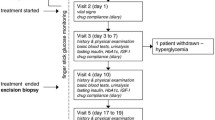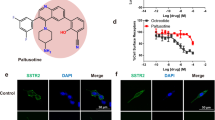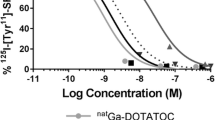Abstract
Investigating three somatostatin receptor (SSTR)-positive (+) human breast cancer cell lines, Xu et al. found a time- and dose-dependent up- or down-regulation of SSTR2 mRNA expression by 17β-oestradiol (E2) or the anti-oestrogen tamoxifen, respectively, in the two oestrogen receptor-positive (ER+) cell lines but not in the oestrogen receptor-negative (ER−) cell line. This study aimed to confirm the findings of Xu et al. at the protein level by means of western blotting and saturation binding studies using 99mTc-depreotide (NeoSpect). The ER+/SSTR+ ZR75-1 and T47D and SSTR+/ER− MDA MB231 breast cancer cell lines were exposed to 1 nM E2 or a combination of 1 nM E2 plus 100 nM tamoxifen or ICI 182 780 (Faslodex) for 48 h. Exposed and non-exposed controls were incubated with increasing concentrations of 99mTc-depreotide (0.5 nM–15 nM) in the absence and the presence of 20 μM of octreotide. Scatchard-Rosenthal plots were derived using commercially available software. SSTR subtypes responsible for E2-induced changes in 99mTc-depreotide binding were identified by means of western blotting. Mean K d values for 99mTc-depreotide were 13 nM, 7 nM and 4 nM for T47D, ZR75-1 and MDA MB231 cells, respectively. After stimulation with E2, the ER+ cell line T47D demonstrated a mean increase of 81% (P<0.05) in 99mTc-depreotide binding. Adding the partial agonist tamoxifen and full antagonist ICI 182 780 to E2 blocked the induced increase in T47D cells, either reducing SSTR expression or restoring it to control levels. ZR75-1 cells stimulated with E2 showed a mean decrease in 99mTc-depreotide binding of 36% as compared to control cells; this difference, however, proved to be not statistically significant. Similarly, B max values did not change in ZR75-1 cells exposed to E2 in combination with an ER antagonist as compared to control cells. Finally, no influence of E2 on 99mTc-depreotide binding was observed in the ER− cell line MDA MB231. Both SSTR2 and SSTR5 were expressed at high levels in T47D cells and ZR75-1 cells. SSTR5 drastically increased in the absence of E2 and was restored to the original detection level after E2 treatment. The presented findings support an oestrogen-dependent regulation of SSTR expression in breast cancer cell lines.



Similar content being viewed by others
References
Raynor K, Reisine T. Somatostatin receptors. Crit Rev Neurobiol 1992; 16:273–289.
Reichlin S. Somatostatin. N Eng J Med 1983; 309:1495–1563.
Patel YC. Somatostatin and its receptor family. Front Neuroendocrinol 1999; 20:157–198.
Lamberts SWJ, Krenning EP, Reubi JC. The role of somatostatin and its analogs in the diagnosis and treatment of tumors. Endocr Rev 1991; 12:450–482.
Seytono-Han B, Schenkelmans MS, Foekens JA, Klijn JGM. Direct inhibitory effects of somatostatin (analogues) on the growth of human breast cancer cells. Cancer Res 1987; 47:1566–1570.
Scambia G, Panici PB, Baiocchi G, Perrone L, Iacobelli S, Mancusco S. Antiproliferative effects of somatostatin and the somatostatin analogue SMS 201-995 on three human breast cancer cell lines. J Cancer Res Clin Oncol 1988; 114:306–308.
Reisine T, Bell G. Molecular biology of somatostatin receptors. Endocr Rev 1995; 16:427–442.
Panetta R, Patel YC. Expression of mRNA for all five human somatostatin receptors (hSSTR1–5) in pituitary tumors. Life Sci 1995; 56:333–342.
Reubi JC, Kappeler A, Waser B, Laissue JA, Hipkin RW, Schonbrunn A. Immunohistochemical localization of somatostatin receptors SS2A in human tumors. Am J Pathol 1998; 153:233–245.
Bruno JF, Xu Y, Song J, Berelowitz M. Molecular cloning and functional expression of a brain-specific somatostatin receptor. Proc Natl Acad Sci U S A 1992; 89:11151–11155.
Hoyer D, Bell GI, Berlowitz M, et al. Classification and nomenclature of somatostatin receptors. Trends Pharmacol Sci 1995; 16:86–88.
Reubi JC, Krenning E, Lamberts SWJ, Kvols L. In vitro detection of somatostatin receptors in human tumors. Metabolism 1992; 41 (9 Suppl 2):104–110.
Vikic-Topic S, Raisch KP, Kvols LK, Vuk-Pavlovic S. Expression of somatostatin receptor subtypes in breast carcinoma, carcinoid tumor, and renal cell carcinoma. J Clin Endocrinol Metab 1995; 80:2974–2979.
Bootsma AH, van Eijck C, Schouten KK, et al. Somatostatin receptor-positive primary breast tumors: genetic, patient and tumor characteristics. Int J Cancer 1993; 54:357–362.
Reubi JC, Waser B, Foekens J, et al. Somatostatin receptor incidence and distribution in breast cancer using receptor autoradiography: relationship to EGF receptors. Int J Cancer 1990; 46:416–420.
van Eijck CHJ, Krenning EP, Bootsma A, et al. Somatostatin-receptor scintigraphy in primary breast cancer. Lancet 1994; 343:640–643.
Reubi JC, Waser B, Schaer JC, Laissue JA. Somatostatin receptor SS1–SS5 expression in normal and neoplastic human tissues using receptor autoradiography with subtype-selective ligands. Eur J Nucl Med 2001; 38:836–846.
Schulz S, Helmholz T, Schmitt J, Franke K, Otto HJ, Weise W. True positive somatostatin receptor scintigraphy in primary breast cancer correlates with expression of sst2A and sst5. Breast Cancer Res Treat 2002; 72:221–226.
Reubi JC, Torhorst J. Relationship between somatostatin, EGF-and steroid-hormone receptors in breast cancer. Cancer 1989; 64:1254–1260.
Xu Y, Song J, Berelowitz M, Bruno JF. Oestrogen regulates somatostatin receptor subtype 2 messenger ribonucleic acid expression in human breast cancer cells. Endocrinology 1996; 137:5634–5640.
Virgolini I, Leimer M, Handmaker H, Lastoria S, Bischof C, Muto P, Pangerl T, Gludovacz D, Peck-Radosavljevic M, Lister-James J, Hamilton G, Kaserer K, Valent P, Dean R. Somatostatin receptor subtype specificity and in vivo binding of a novel tumor tracer,99mTc-P829. Cancer Res 1998; 58:1850–1859.
Lister-James J, Pearson DA, De Rosch MA, et al. Tc-99m P829: characterization of a technetium-99-labeled somatostatin receptor-binding peptide. In: Nicolini M, Mazzi U, eds. Technetium, rhenium and other metals in chemistry and nuclear medicine. Padua: SGE; 1999:473–478.
Vallabhajosalu S, Moyer BR, Lister-James J, et al. Preclinical evaluation of technetium-99m-labeled somatostatin receptor-binding peptides. J Nucl Med 1996; 37:1016–1022.
Berthois Y, Katzenellebogen JA, Katzenellebogen BS. Phenol red in tissue culture media is a weak estrogen: implications concerning the study of estrogen-responsive cells in culture. Proc Natl Acad Sci U S A 1986; 83:2496–2500.
Helboe L, Møller M, Nørregaard L, Schiødt M, Stidsen CE. Development of selective antibodies against the human somatostatin receptor subtypes SS1–SS5. Mol Brain Res 1997; 49:82–88.
Kimura N, Tomizawa S, Arai KN, Kimura N. Chronic treatment with oestrogen up-regulates expression of SS2 messenger ribonucleic acid (mRNA) but down-regulates expression of SS5 mRNA in rat pituitaries. Endocrinology 1998; 139:1573–1580.
Djordjijevic D, Zhang J, Priam M, et al. Effect of 17beta-estradiol on somatostatin receptor expression and inhibitory effect on growth hormone and prolactin release in rat pituitary cell cultures. Endocrinology 1998;139:2272–2277.
Xu Y, Berelowitz M, Bruno JF. Dexamethasone regulates somatostatin receptor subtype specific messenger ribonucleic acid expression in rat pituitary GH4C1 cells. Endocrinology 1995; 136:5070–5075.
Visser-Wisselaar HA, Van Uffelen CJC, Van Koetsveld PM, et al. 17 Estradiol dependent regulation of somatostatin receptor subtype expression in the 7315 b prolactin secreting rat pituitary tumor in vitro and in vivo. Endocrinology 1997; 138:1180–1189.
Xu Y, Berelowitz M, Bruno JF. Characterization of the promoter region of the human somatostatin receptor subtype 2 gene and localization of sequences required for estrogen-responsiveness. Mol Cell Endocrinol 1998; 139:71–77.
Masters JR, Thomson JA, Daly-Burns B, et al. Short tandem repeat profiling provides an international reference standard for human cell lines. Proc Natl Acad Sci U S A 2001; 98:8012–8017.
Schaer JC, Waser B, Mengod G, Reubi JC. Somatostatin receptor subtypes SS1, SS2, SS3 and SS5 expression in human pituitary, gastroentero-pancreatic and mammary tumors: comparison of mRNA analysis with receptor autoradiography. Int J Cancer 1997; 70:530–537.
Acknowledgements
The authors wish to thank Dr. C.E. Stidsen (Novo Nordisk, Denmark) for providing the SSTR subtype-specific antibodies and Prof. M. Mareel for offering encouraging support during the binding experiments. Dr. B. Van Den Bossche has prepared this manuscript as part of her PhD course in the Nuclear Medicine Unit at the University of Rome “La Sapienza” and wishes to thank Prof. F. Scopinaro and Dr. A. Signore for their support and useful suggestions in preparing the manuscript.
Author information
Authors and Affiliations
Corresponding author
Rights and permissions
About this article
Cite this article
Van Den Bossche, B., D’haeninck, E., De Vos, F. et al. Oestrogen-mediated regulation of somatostatin receptor expression in human breast cancer cell lines assessed with 99mTc-depreotide. Eur J Nucl Med Mol Imaging 31, 1022–1030 (2004). https://doi.org/10.1007/s00259-004-1500-6
Published:
Issue Date:
DOI: https://doi.org/10.1007/s00259-004-1500-6




